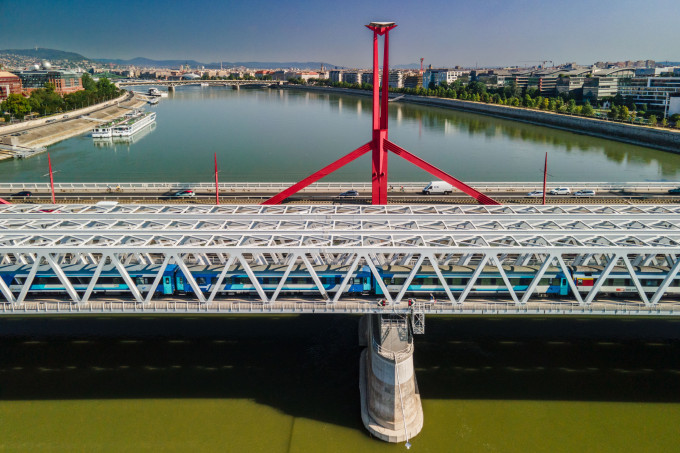Hungary submits railway plans for EU funding, crucial projects are missing 26/01/23
< Zurück
The Hungarian government submitted a funding request to EU’s Connecting Europe Facility 2 for several domestic railway projects. Although some of the railway schemes included in the proposal are relevant for rail freight development in the country, two critical projects were left out: Budapest’s Danube railway tunnel and the V0 line.
Some of the most important freight-related projects that Hungary seeks to fund via the EU include the alignment of railway tracks between Kelenföld and Ferencváros with the triple track of the Danube railway bridge, and the construction of three new terminals within Budapest, in Nádorkert, Közvágóhíd and Népliget.
Additionally, the Hungarian government plans to replace the Gubasci bridge in the south of Budapest with a new structure that will have a double track and enhance connectivity between terminals located in Budapest and trains transiting on the Budapest-Kelebia-Belgrade line. Other investment plans concern the Budapest-Debrecen line, which is almost complete, the border crossing area with Ukraine, which will see exclusively freight-dedicated investments and a railway line connecting to Austria.
Missing projects
All those plans seem right on point. But what is more striking is the absence of other projects. Although he is positive about the steps taken forward, Hungarian rail expert Akos Ersek who represents the industry at the UIRR sees two flagship projects missing. First is the Danube tunnel study. “The new transport minister decided to take the study of the Danube tunnel between Ferencváros and Kelenföld out of the funding proposal,” says Ersek.
 Image: © Akos Ersek.
Image: © Akos Ersek.
The tunnel would create two underwater railway lines for passenger services. This would mean that the Danube three-track railway bridge would get alleviated by the bulk of passenger trains crossing it and open up space for more freight trains. In any case, freight trains can only use this bridge to cross the Danube and reach Budapest’s two end stations.
Despite the freight sector routing to commence the tunnelling activities, the study did not proceed. “The study was awarded in the past and would be funded by 90 per cent from the EU,” underlines Ersek, wondering why a doubled river-crossing capacity project was thrown in the archives.
 Danube Railway Bridge. Source: © MAV.
Danube Railway Bridge. Source: © MAV.
No V0?
Another major project overlooked by the Hungarian administration is the notorious V0 line, which would bypass Budapest’s ring route. V0 would connect Szolnok, located in the east of the country near the Zahony region, with the city of Győr, very close to the Hungarian border with Austria and Slovakia and not far from Bratislava and Vienna. The line would bypass Budapest, which is a traffic bottleneck. The main aim of the line would be to move international rail freight out of the city, making the V0 railway line a freight-only corridor.
International rail freight companies active in Hungary, like RTSB, and local terminals, like East West Gate, relied on V0’s construction to achieve larger capacity and seamless rail freight movements. However, this will not be the case, at least not soon. “The V0 project should have a study submitted in this CEF call, but this did not happen mainly due to political disputes concerning the future line’s route,” says Ersek.
Kelenföld-Ferencváros
But even the projects that have been included in the proposal may face some hick-ups, for example the track alignment between Kelenföld and Ferencváros, Ersek points out. The main issue, in this case, is that the Danube railway bridge connecting these two locations has three tracks. However, both sides have only a double track leading to the bridge. The objective is to triple tracks on both sides of the Danube river and, thus, align with the bridge’s infrastructure, he explains.
“The project will basically take place only between Ferencváros and the bridge,” underlines the Hungarian rail freight expert. This is on Danube’s east bank. On the river’s west bank, which leads to Kelenföld, residents protest the railway capacity extension, meaning that the project will probably not proceed for the time being. Under these circumstances, “the track alignment with the Danube bridge will improve capacity only by 15 per cent instead of 30 per cent,” notes Ersek.
On top of that, he adds: “MAV will need to establish a whole new operational protocol for this rail line since there is no other place in the country where the company operates a three-track line. It will take time and lots of preparation and studying for train path allocation, for instance, before the line opens.”
Long-term perspective gone
The conclusion concerning Hungary’s latest CEF call submission is that projects that will probably run will benefit rail freight and especially connectivity with Ukraine, which is needed. However, especially when crossing the Danube and providing extra rail freight capacity, “more is not done, and the long-term perspective seems to be gone,” concludes Ersek.





